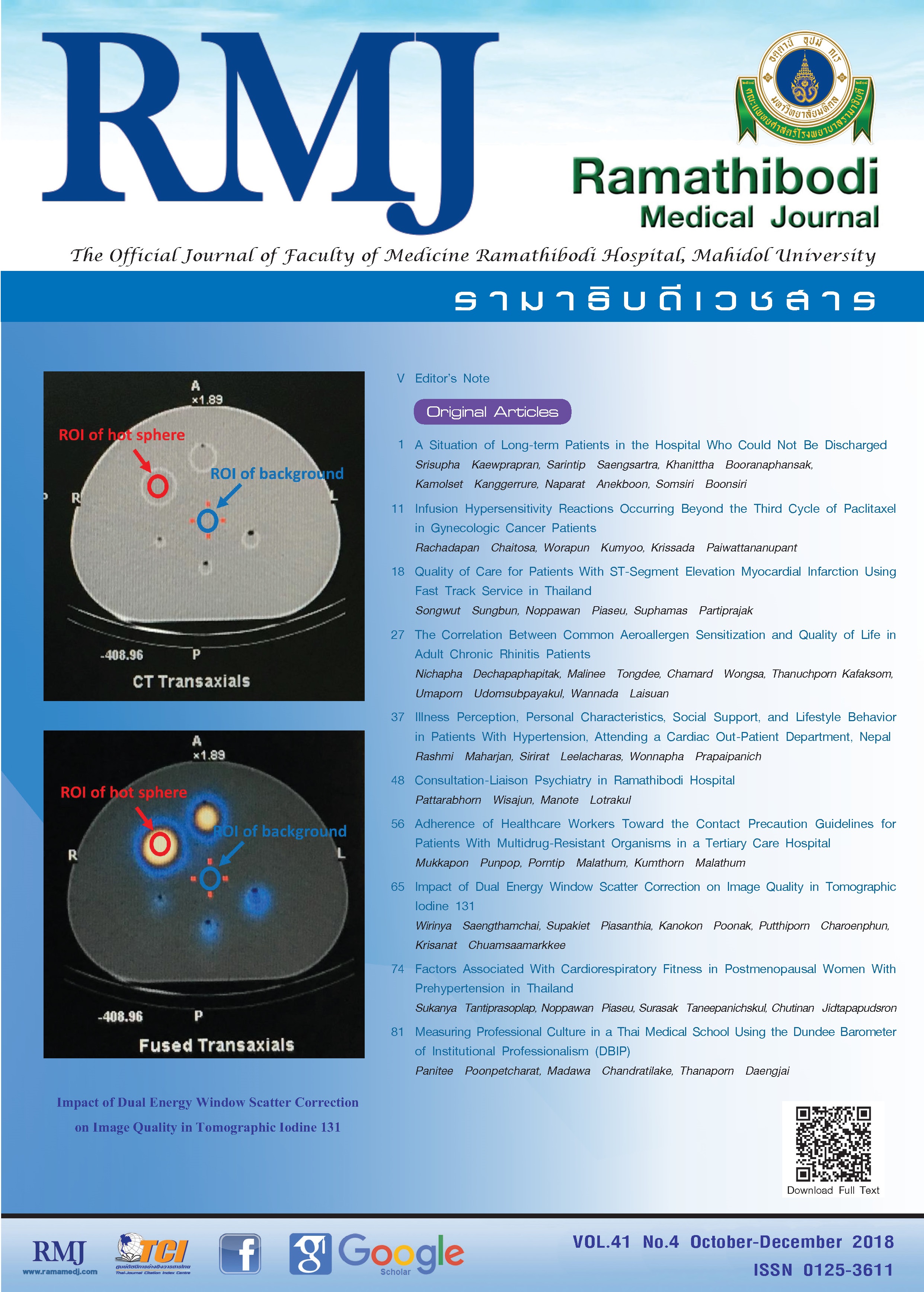Measuring Professional Culture in a Thai Medical School Using the Dundee Barometer of Institutional Professionalism (DBIP)
Main Article Content
Abstract
Background: Social change together with advances in technology and medical knowledge are impacting on the way doctors and health care providers work. As a consequence, there is greater interest in medical professionalism.
Objective: To conduct field test of a Thai-version of the Dundee Barometer of Institutional Professionalism (DBIP) for measuring Thai medical students’ attitude towards medical professionalism.
Methods: The originator of DBIP was asked permission to translate. The DBIP was translated into the Thai language through a cross-cultural adaptation process for content validity. The process were forward and back translation and being relevant within Thai context. A paper-based self-administered version of the Thai DBIP questionnaire was distributed to 420 clinical-year medical students (4th to 6th year) at the Faculty of Medicine Ramathibodi Hospital, Mahidol University, Bangkok, Thailand. Statistical analysis was undertaken using SPSS version 18.0 in descriptive statistics and internal consistency.
Results: The response rate was 77.6% with Cronbach’s alpha 0.96. The results indicated a positive attitude towards medical professionalism. Professional attitudes appeared to be valued more by female students than by their male counterparts and more by older students than by younger ones.
Conclusions: The result of Cronbach’s alpha indicated that the reliability of the Thai-version of the DBIP was excellent. Students had high levels of concern for professionalism. Nevertheless, medical schools should emphasise the need for continuous professional development.
Article Details
References
2. Working Party of the Royal College of Physicians. Doctors in society. Medical professionalism in a changing world. Clin Med (Lond). 2005;5(6 Suppl 1):S5-S40.
3. O'Sullivan H, van Mook W, Fewtrell R, Wass V. Integrating professionalism into the curriculum: AMEE Guide No. 61. Med Teach. 2012;34(2):e64-e77. doi:10.3109/0142159X.2012.655610.
4. Chandratilake M. Development and validation of an inventory (Dundee Barometer of Institutional Professionalism) to measure the professionalism culture of medical school in the UK (Unpublished doctoral dissertation). Scotland, UK: University of Dundee; 2012.
5. Ajzen I. The theory of planned behaviour. Organisational Behaviour and Human Decision Processes. 1991;50(2):179-211. doi:10.1016/0749-5978(91)90020-T.
6. Frank JR. The CanMEDS 2005 Physician Competency Framework. Better standard. Better physicians. Better care. Ottawa, Canada: The Royal College of Physicians and Sergeons of Canada; 2005. https://www.royalcollege.ca/portal/page/portal/rc/common/documents/canmeds/resources/publications/framework_full_e.pdf. Accessed May 31, 2018.
7. Chandratilake M, McAleer S, Gibson J, Roff S. Medical professionalism: what does the public think? Clin Med (Lond). 2010;10(4):364-369.
8. Chandratilake M, McAleer S, Gibson J, Roff S. Personal, professional and cultural differences in the perception of healthcare professionalism. Paper presented at: the Annual Meeting of the Association for the Study of Medical Education (ASME), 21 - 23 July 2010, Cambridge, UK: Robinson College; 2010.
9. Beaton DE, Bombardier C, Guillemin F, Ferraz MB. Guideline for the process of cross-cultural adaptation of self-report measure. Spine (Phila Pa 1976). 2000;25(24):3186-3191.
10. Hulley SB, Cummings SR, Browner WS, Grady DG, Newman TB. Designing clinical research. 4th ed. Philadelphia, PA: Lippincortt Williams & Wilkins; 2013.
11. National Statistic Service. Questionnaire design. https://www.nss.gov.au/nss/home.nsf/2c4c8bd01df32224ca
257134001ea79a/0201e2012ff0708eca2571ab00247a1b?OpenDocument. Accessed May 31, 2018.
12. Miller GE. The assessment of clinical skills/competence/performance. Acad Med. 1990;65(9 Suppl):S63-S67.




